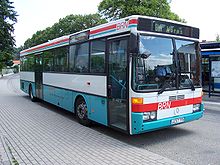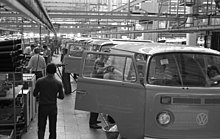Commercial vehicle manufacturer
Commercial vehicle manufacturers are companies that lorries (trucks) and / or buses produce various sizes, smaller vans and special vehicles.
General
In addition to trucks of all sizes, tractors , articulated lorries and vans , buses, including public buses , coaches and trolleybuses with electric drives (also known as trolleybuses) and special vehicles of various types such as crane trucks and military vehicles are also part of the range of commercial vehicle manufacturers. The equally to the commercial vehicles counting smaller vans other hand, are usually from car manufacturers built as these the cars are structurally much closer to it in part as heavy commercial vehicles and also to corresponding car is -models derived structures.
Current market situation
The market for commercial vehicles is highly competitive and is dominated by large companies today, but medium-sized companies have also been able to hold their own in market niches . Nevertheless, a massive concentration process can be observed over the decades, in the course of which providers merged , were taken over and left the market. After a certain calming down since the 1980s, mergers, takeovers and also stronger technical cooperation between different independent manufacturers have taken place in the recent past.
Group-wide cooperation is particularly pronounced in the field of small vans, where relatively similar or almost identical vehicles are now often positioned within the framework of badge engineering from different providers. Often these vehicles, which have only slight visual differences to emphasize the independence of the respective brand, are even built for different manufacturers in the same automobile plant.
While a few large companies almost completely dominate the market in the conventional truck segment in the large industrialized countries, the bus manufacturer segment has retained an even more heterogeneous structure. In this area, there is also a stronger focus of the country markets on manufacturers from their own country, provided that the respective country still has such manufacturers.
The larger corporations that dominate today often produce several brands , sometimes these companies appear under different brand names in different countries, for example because certain names (from traditional manufacturers that have been taken over) are particularly strong or well-known in certain countries. In many cases, commercial vehicle manufacturers are parts of large automotive groups that are also active in the passenger car sector.
In contrast to the passenger car market, the influence of Asian brands in the truck and bus sector in Europe is very low; at most in the light truck sector, individual models were able to achieve modest sales figures. However, Japanese manufacturers in particular are well represented in the market for small vans of the smaller sizes (see VW bus ).
literature
- German delivery vans · All brands and models up to 1.5 tons since 1896 , Motorbuch-Verlag, Stuttgart 1998, ISBN 3-613-01878-0
- Wolfgang Gebhardt: German omnibuses since 1895 , Motorbuch-Verlag, Stuttgart 2002, ISBN 3-613-02140-4
- Werner Oswald : German trucks and delivery vehicles 1945-1970 , Volume 2, Motorbuch-Verlag, Stuttgart 2002, ISBN 3-613-02391-1
- Werner Oswald: German trucks and delivery vehicles 1970–1989 , Volume 3, Motorbuch-Verlag, Stuttgart 2002, ISBN 3-613-02446-2
- Trucks of the World · The Lexicon of Brands and Models , Motorbuch-Verlag, Stuttgart 2000, ISBN 3-613-02257-5
- The truck lexicon · All brands 1900 to today , Motorbuch-Verlag, Stuttgart 1998, ISBN 3-613-01837-3
- Lastauto-Omnibus-Catalog , various issues, ETM EuroTransportMedia


